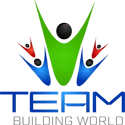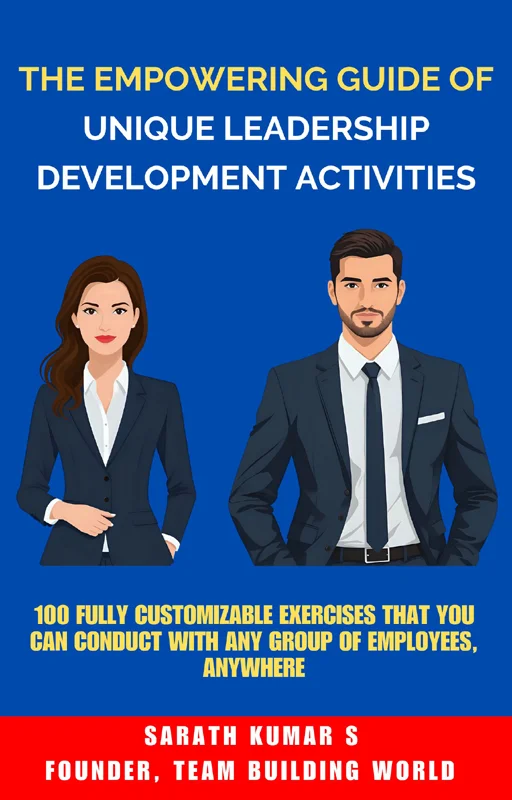10 Team Building Activities with Paper for Adults
Are you in search of some team building activities with paper?
Experiential learning exercises are an effective way to boost collaboration, improve communication, and foster camaraderie in the workplace. Using just paper, you can create engaging exercises that bring employees together to solve problems, think creatively, and have a great time.
In this article, let’s see 10 team building activities using paper for adults in your workplace. These exercises can help break the monotony of daily work and bring some fun into the office.
10 Team Building Activities with Paper for Adults
Here are some creative and fun team building exercises that you can do with just paper.
#1. The Paper Tower Challenge
This is a fast-paced activity where teams compete to build the tallest standing paper tower. It encourages creativity, teamwork, and quick problem-solving skills.
Time 10-15 minutes
Materials Sheets of paper and tape
Participants Small teams of 3-6 members
Instructions
- Give each team an equal number of paper sheets and a set amount of tape.
- Ask the teams to construct the tallest freestanding tower within the time limit using only these materials.
- Encourage them to experiment with different folding techniques, such as rolling or layering, to maximize stability.
- Once the time is up, measure each tower and declare the tallest as the winner.
Debrief
Discuss how the teams approached the task and adapted to challenges. Reflect on how collaboration and effective planning contributed to the outcome.
You can also read: 10 Cooperative Team Building Games for Adults
#2. Plane Contest
This activity allows participants to showcase their design and engineering skills. It encourages creativity, problem-solving, and teamwork while also fostering a sense of friendly competition among colleagues.
Time 10-20 minutes
Materials Sheets of paper
Participants 2-6 people per group
Instructions
- Provide the participants with sheets of paper and instruct them to design as well as fold paper airplanes.
- Set a designated area for airplane flights and establish a takeoff line.
- Each team takes turns flying their paper plane. Measure the distance or accuracy of each flight.
- You can create different categories such as longest distance, most accurate flight, or most creative design and award points accordingly.
Debrief
Discuss how the participants approached the task, including their design strategies and any adjustments they made after testing. Highlight how creativity and experimentation contributed to success.
You can also read: 10 Empowerment Team Building Activities for the Workplace
#3. Origami Collaboration
This activity combines creativity and teamwork as participants work together to create origami designs. It also promotes communication and problem-solving skills.
Time 15-20 minutes
Materials Sheets of paper with printed origami instructions (or demonstrate steps)
Participants Groups of 3-6 individuals
Instructions
- Provide each group with origami instructions and sheets of paper.
- Assign each group member a specific part of the origami process to complete. For example, one person may fold the base, while others work on refining details.
- Groups collaborate to create the final origami piece and can choose between simple objects like paper cranes or more advanced designs.
- Once completed, groups display their creations and optionally share the process they used.
Debrief
Discuss the importance of assigning roles and effective communication during team tasks. Highlight how combining individual contributions leads to a shared accomplishment.
You can also read: What Makes a Good Team Building Activity?
#4. Chain Race
This activity challenges teams to create the longest paper chain. It strengthens time management and collaboration.
Time 10-15 minutes
Materials Sheets of paper, scissors, and tape or glue
Participants Teams of 4-8 members
Instructions
- Distribute materials equally among teams.
- Set a time limit and instruct teams to create the longest continuous paper chain they can within that time.
- Teams must coordinate their cutting, glueing, and assembling efforts to maximize efficiency.
- At the end of the time, measure each chain and declare the longest one as the winner.
Debrief
Reflect on how the teams divided responsibilities and their strategies for optimizing speed and accuracy. Discuss how time pressure influenced decision-making and teamwork.
#5. Newspaper Bridge
This engineering-themed challenge pushes teams to think structurally and innovatively. It promotes creativity, problem-solving, and collaboration as employees experiment with different techniques to build the strongest bridge.
Time 15-20 minutes
Materials Newspapers, tape, and a small weighted object (e.g., a book or toy)
Participants 3-6 people per group
Instructions
- Provide newspapers and tape to each team. Now, assign the task of building a bridge that can hold the weight of the small object.
- Clarify that the bridge must be freestanding and long enough to span a designated gap or distance.
- Teams can experiment with folding, layering, or rolling techniques to build stability.
- Test each bridge by placing the object on it to determine whether it holds and evaluate which one is the strongest overall.
Debrief
Discuss the strategies teams used to solve the structural challenge and how they adapted their designs after testing. Highlight the value of trial and error in problem-solving.
#6. Hidden Picture Puzzle
This activity enhances observation skills and encourages collaboration as teams search for hidden images or patterns. It also boosts teamwork, communication, and problem-solving skills.
Time 15-20 minutes.
Materials Large printed sheets with hidden pictures or designs, and markers
Participants Teams of 3-6 members
Instructions
- Provide each team with a printed sheet containing a complex image or pattern with hidden pictures or symbols embedded within it.
- Assign a time limit for the teams to locate as many hidden items as they can and circle or mark them on the sheet.
- Teams can strategize on how to divide the image into sections or combine their efforts to scan it more efficiently.
- At the end of the time, count the number of correctly identified pictures and declare the team with the most accurate findings as the winner.
Debrief
Discuss how teams approached the challenge, including their scanning techniques and collaboration methods. Reflect on the importance of attention to detail and teamwork when solving puzzles under time constraints.
#7. Story Creation
This creative exercise stimulates storytelling while promoting teamwork and shared creativity. Here the teams create a collaborative story by drawing random words or phrases from a shared pool.
Time You decide
Materials Strips of paper, pens, and a container or bowl
Participants Groups of 3-8 individuals
Instructions
- Provide each team with strips of paper and instruct them to write down single words or short phrases on each strip. Words can range from random nouns and verbs to themes or emotions.
- Place the strips in a container, mix them, and assign each team to draw a set number of strips.
- Each team must work together to create a cohesive and engaging story using the words they have collected.
- Once completed, teams can share their stories with others for a fun and creative exchange.
Debrief
Discuss how the teams collaborated to build their narratives and tackled challenges like integrating unrelated words. Highlight how creativity and teamwork can shape unexpected as well as entertaining outcomes.
#8. Fortune Teller Debate
This interactive activity combines fun, creativity, and debate. Here the employees create a custom paper fortune teller with workplace-themed topics and take turns using it to spark dynamic conversations.
Time 15-20 minutes.
Materials Sheets of paper, and pens
Participants Pairs or small teams of 3-6 members
Instructions
- Teach the participants how to fold a traditional paper fortune teller (also known as a cootie catcher).
- Instead of standard fortunes, each flap should contain a debate topic, question, or scenario related to workplace goals, productivity, or fun hypothetical situations.
- Teams take turns “playing” the fortune teller and debating or discussing the chosen topics. Encourage them to brainstorm creative or humorous responses.
- Afterward, teams can reflect on memorable conversations and key takeaways.
Debrief
Discuss the value of open communication and different perspectives in promoting collaboration. Highlight how humor and lighthearted debates can strengthen team bonds.
#9. Collaborative Paper Mural
This cooperative activity focuses on creativity and collective achievement. Here the groups collaborate to design a mural based on a shared theme.
Time You decide
Materials Large sheets of paper, colored markers, and tape (optional for display)
Participants Groups of any size
Instructions
- Provide each team with a large sheet of paper and encourage them to design a section of a mural.
- Assign a theme for inspiration, such as teamwork, innovation, or positivity.
- Once the teams have completed their individual sections, combine them to form a cohesive mural.
- Optionally, display the completed mural in the workplace as a reminder of collaboration and creativity.
Debrief
Discuss how each team contributed and how the separate designs came together to form a unified picture. Reflect on the power of collective efforts and shared vision in achieving goals.
#10. Puzzle Exchange
In this problem-solving challenge, teams solve puzzles created by others. It encourages adaptability, collaboration, and critical thinking.
Time You decide
Materials Sheets of paper, pens, and scissors
Participants 3-8 people in a group
Instructions
- Ask each team to design their own paper puzzle or maze by drawing patterns, cutting shapes, or creating other challenges.
- Once completed, teams exchange puzzles with one another.
- Teams work to solve the puzzles created by their peers within a set time limit.
- The team that solves the puzzle fastest, or creates the most challenging puzzle, can be awarded recognition.
Debrief
Discuss the importance of thinking from different perspectives, both as puzzle creators and solvers. Highlight how shared activities can build understanding and foster adaptability in problem-solving.
Want Some Unique Leadership Development Activities?
If you want some unique activities to equip your employees (both in-person and virtual) with leadership skills, qualities, and mindset, you can get my premium e-book:
Or Want Some Unique Team Building Activities?
If you want some unique activities for your employees (both in-person and virtual), you can get my premium e-book:
Final Words
These paper-based team building activities are easy to organize, cost-effective, and enjoyable for everyone involved. They also illustrate the value of collaboration, creativity, and communication in achieving common goals. Continue exploring different activities and adapt them to your team’s specific needs for continued growth. Let these be just a starting point for building an engaged and cohesive team dynamic.
FAQ: Team Building Activities with Paper
You might have these questions in mind.
How can these activities be customized for larger groups?
Many of the activities outlined can be scaled up for larger groups by dividing the participants into smaller teams or adjusting the resources provided. For example, in the Collaborative Paper Mural activity, you could assign multiple mural themes, allowing multiple teams to work simultaneously, and then piece their work together for an expansive final display. Similarly, for the Story Creation, larger groups can create more intricate or interconnected stories by combining contributions from multiple teams.
Can these activities be adapted for virtual teams?
Absolutely! Although these activities involve physical paper, digital tools can easily serve as substitutes. For instance, you can use virtual drawing tools or collaborative platforms such as Google Jamboard for creating murals, or shared documents for crafting stories collectively. Puzzle creation and exchange activities could be done via virtual whiteboards, bringing the same sense of creativity and problem-solving to remote settings.
What should facilitators consider when choosing an activity?
Facilitators should consider the goals of the session, the size of the group, and the participants’ preferences. Thoughtfully balancing creativity, problem-solving, and fun ensures engagement as well as inclusiveness. Keep in mind the time required for each activity and adjust as necessary to fit within the schedule while maintaining the energy of the group.

